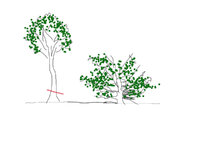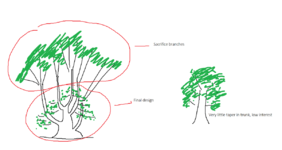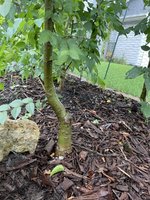Kahless
Yamadori

I’m growing some trees (elms, maples, hornbeams) in the ground and would like thicker trunks. I have a lot that look like the tree on the left, lots of growth way up top and few branches near the bottom. None of them are thick enough for a chop yet since I like bigger trunks. I would just come back to them and chop (red line) when I am ready. Someone saw one of my elms and said all the growth at the top was a “waste” and that I should chop it low now, but the trunk is only half as big as I want it, and I know once I chop it will grow much slower. I had a few trees that looked like the one on the right with lots of low bushy growth, but once I came back to them after a growing season I realized that there was inverse taper where multiple branches came out and would need to be chopped below that area anyways to fix this. Doesn’t high growth thicken just as well as low? I thought it thickens anything below it. Which one of these two is better? My trees are close together so high growth is less likely to be shaded out by neighboring trees. Thanks!



